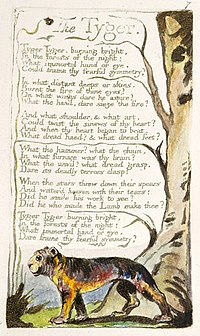|
The Tyger
"The Tyger" is a poem by the English poet William Blake, published in 1794 as part of his Songs of Experience collection and rising to prominence in the romantic period. The poem is one of the most anthologised in the English literary canon,[1] and has been the subject of both literary criticism and many adaptations, including various musical versions.[2] The poem explores and questions Christian religious paradigms prevalent in late 18th century and early 19th century England, discussing God's intention and motivation for creating both the "Lamb" and the eponymous "Tyger."[3] The Songs of ExperienceThe Songs of Experience was published in 1794 as a follow-up to Blake's 1789 Songs of Innocence.[4] The two books were published together under the merged title Songs of Innocence and of Experience, showing the Two Contrary States of the Human Soul: the author and printer, W. Blake[4] featuring 54 illustrated plates. In some copies, plates are arranged differently and a number of poems are moved from Songs of Innocence to Songs of Experience. Blake printed the work throughout his life.[5] Of the copies of the original collection, only 28 published during his life are known to exist, with an additional 16 published posthumously.[6] Only five of the poems from Songs of Experience appeared individually before 1839.[7] Poem
Structure"The Tyger" is six stanzas in length with each stanza containing four lines. The meter of the poem is largely trochaic tetrameter. A number of lines, such as line four in the first stanza, fall into iambic tetrameter.[10] The poem is structured around questions that the speaker poses concerning the "Tyger," including the phrase "Who made thee?" These questions often repeat instances of alliteration ("frame" and "fearful") and imagery (burning, fire, eyes) to frame the arc of the poem. The first stanza opens the poem with a central line of questioning, stating "What immortal hand or eye, / Could frame thy fearful symmetry?". This direct address to the creature serves as a foundation for the poem's contemplative style as the "Tyger" cannot provide the speaker with a satisfactory answer. The second stanza questions the "Tyger" about where it was created, while the third stanza sees the focus move from the "Tyger" to its creator.[11] The fourth stanza questions what tools were used in the "Tyger's" creation. In the fifth stanza, the speaker wonders how the creator reacted to its "Tyger" and questions the identity of the creator themselves. Finally, the sixth stanza reprises the poem's first stanza but rephrases the last line, altering its meaning: rather than question who or what "could" create the "Tyger", the speaker wonders who would "dare," effectively modifying the tone of the stanza to present as more of a confrontation than a query. Themes and critical analysis"The Tyger" is the sister poem to "The Lamb" (from "Songs of Innocence"), a reflection of similar ideas from a different perspective. In "The Tyger", there is a duality between beauty and ferocity, through which Blake suggests that understanding one requires an understanding of the other. "The Tyger," as a work within the "Songs of Experience," was written as antithetical to its counterpart from the "Songs of Innocence" ("The Lamb") – a recurring theme in Blake's philosophy and work. Blake argues that humankind's struggles have their origin in the contrasting nature of concepts. His poetry argues that truth lies in comprehending the contradictions between innocence and experience. To Blake, experience is not the face of evil, but rather a natural component of existence. Rather than believing in war between good and evil or heaven and hell, Blake believed that each man must first see and then resolve the contraries of existence and life.[11] Therefore, the questions posed by the speaker within "The Tyger" are intentionally rhetorical; they are meant to be answered individually by readers instead of brought to a general consensus.[12] Colin Pedley and others have argued that Blake may have been influenced in selecting the animal by the death of a son of Sir Hector Munro by a tiger in December 1792.[13] Musical versionsBlake's original tunes for his poems have been lost in time, but many artists have tried to create their own versions of the tunes.[14]
Bob Dylan refers to Blake's poem in "Roll on John" (2012).[17] Five Iron Frenzy uses two lines of the poem in "Every New Day" on Our Newest Album Ever! (1997). Joni Mitchell uses two lines in her song about the music industry, the title track of her 1998 album Taming the Tiger.[18] See also
References
Sources
External linksWikimedia Commons has media related to The Tyger. Wikisource has original text related to this article:
|
||||||||||||||||||
